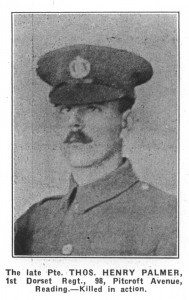Thomas Henry Palmer
Private 9829
1st Battalion Dorsetshire Regiment
Division 12
 |
Thomas Henry Palmer’s home address was 98, Pitcroft Avenue, Reading. He is commemorated on a his family’s grave. His father was James Palmer, a railway clerk and his mother Rosalind Palmer. The 1911 census indicates that Rosalind had borne nine children although only four servived. A daughter Rosalind May Keys, her husband Herbert and son Charles were living with the Palmer family. Thomas’s two sisters Alice and Bessie were also living in the family home. Thomas enlisted on 27July 1914, some days before the official declaration of war. Perhaphs with the intention of making acareer change. He was almost 24 years old. He joined the Dorset Regiment on 7 August and he was posted on active service overseas in October 1914. His service record on Ancestry UK indicates that his occupation was that of a fitter and turner. Thomas had served in the 1st/4th Royal Berkshire Regiment (Territorial Force) before the enlisting in the Dorset Regiment. His mother Rosilind is given as his nextof kin in the service record and it was she who received his medals and personal effects upon his death. Thomas Palmer was killed in action on the 26th April 1915. He is buried at White House Cemetery, St. Jean-les-Ypres, location IV. A.42.
Although the commemoration on the kerbs states killed in action in France, Thomas is actually buried in Belgium. The “White House” was on the Ypres road, between St. Jean and the bridge over the Bellewaardbeek. The cemetery was begun in March, 1915, and used until April, 1918, by units holding this part of the line. Originally it contained Plots I and II; but after the Armistice these Plots were completed, and III and IV added, by the concentration of graves from the battlefields round Ypres and from smaller burial grounds. Thomas Palmer’s service record states that he died from the effects of a gunshot wound. It is probable that his body was brought to the White House Cemetery from a smaller burial ground belonging to a casualty clearing station after the Armistice .
The Second Battle of Ypres had begun on 22nd April 1915. The Germans used poison gas for the first time during the next week. On 26th April the British launched counter attacks against the Germans south-east of Pilckem and towards St. Julien. The efforts came to naught with the British incurring 4,000 casualties during the day as they faced the superior German machine guns and artillery. Thomas Palmer is believed to have been a casualty of the fighting which took place in the area.